danbricklin.com/log
|
||
|
|
Starting March 3, 2003
Computer History Museum talk, Updates to VisiCalc history in preparation for speech, Adam Osborne, Start of PC Forum, Quality of service discussion, Atlanta again: A Segway and the Blackberry advertisement, Search Engine Strategies 2003 conference report, Boston Museum of Science Computing Revolutionaries event
03Mar03-09Apr03
2003_03_03.htm
|
|
|
Computer History Museum talk [link]
Last night, Bob Frankston and I gave a guest lecture for the Computer History Museum. Joining us on stage was Mitch Kapor, and Charles Simonyi moderated. The Museum is in the midst of moving their collection into a gorgeous new building right off of 101 in Mountain View, California, a couple of miles from Moffett Field.
Bob, Charles, and I met at the new building to see how renovations were coming, walk around parts of the collection that have already been moved, and talk:
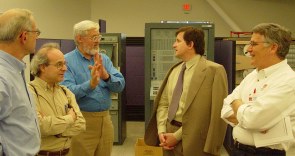 Bob and Charles discuss old machines with Computer History Museum people
At 6 pm we went over to the Silicon Valley Microsoft campus to an auditorium for the talk. We joined up with Mitch and sat for some publicity photos:
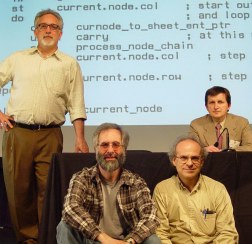 Mitch Kapor, Dan Bricklin, Bob Frankston, Charles Simonyi, in front of image of part of a listing of the source code for VisiCalc
There was a reception where we ran into all sorts of people from the old days, as well as new. I saw my old college roommate from senior year, David Stork, ex-VisiCorp people Peter Jennings, Ed Esber, Roy Folk, and others, Bob's sister-in-law and brother-in-law (who were among the few who attended Bob's original talk about VisiCalc at the NCC in 1979 when VisiCalc was announced), Donald Knuth, Larry Magid, and many others. In honor of the event, Peter Jennings told me he had just posted some of his remembrances of VisiCalc on one of his web sites (he was one of the early senior management at Personal Software/VisiCorp, from before the time they published VisiCalc).
For the 2 hour talk/Q&A, Charles started by asking questions such as "What was your first computer? Do you remember how it smelled?", and then more specific ones about coming up with the ideas, coding, etc. Questions from the audience included ones about why VisiCalc succeeded, relationships with other companies, etc. It was helpful having Mitch and the VisiCorp people there to add their comments. Afterwards, some of us went out to dinner and talked more. It was a great event. A videotape should be available on the Computer History Museum web site in a week or so, they tell me.
 The audience at the beginning of the talk: One side...
 ...and the other
Visit to see Pyra at Google [link]
I'm out in the Bay Area for the VisiCalc talk and dropped in to see Evan Williams and the Pyra team at Google. I'm writing this in Ev's office. Here are some pictures:
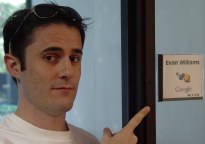 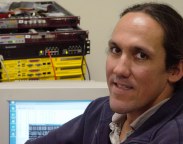 Ev at his office at Google, Rudy Winnacker in front of the development servers he maintains so Ev et al can get work done
![Building sign: Google, 1505 Salado Drive, Building [PI symbol] 3.14159...](a52e88c0.jpg) 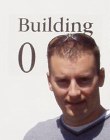 Google numbers their buildings their own way: The building with Blogger people at 1505 Salado Drive, Pyra's Jason Shellen in front of the sign at what they told me was their first building where CEO Eric Schmidt has an office
I saw Sergey Brin riding a Google Segway (they have a couple for employees who take the training to get around the campus) and I just missed seeing Larry Page ride by. Sorry, I didn't get any pictures...
I'll do a report on the Museum presentation tonight in the next day or two.
Updates to VisiCalc history in preparation for speech [link]
Bob Frankston and I will be speaking at a special event at the Computer History Museum in Mountain View, California, next Tuesday night, April 8, 2003. We will be part of a discussion about the origin and impact of VisiCalc. We'll answer questions about how and why we built it the way we did. Joining us on stage will be Mitch Kapor, leader of the Lotus 1-2-3 product development. I invited one other person to moderate and ask questions: Charles Simonyi, who hired and managed the teams at Microsoft that created Multiplan, Excel, Word, etc. In the audience, according to a list I saw, will be other people from those early days in personal computing software. For computer history buffs and software design people it should be a cool event. If you are planning to attend, please sign up on the museum web site. The event will be videotaped (to be added to the museum's vast collection of tapes of computer pioneers). I believe strongly in the value of saving historical material and learning from it, and the Computer History Museum is one of the best ways to do that today. I hope this event will help raise its profile among software people as they prepare to move into their new building.
In preparation, I have finally added some more material to the History section of my website, including additional pictures with explanation from the slide show I've given over the years. See "Software Arts and VisiCalc", starting with "The Idea". I still have lots more to add, and hope to have some additional material added by the end of next week.
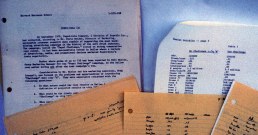 "Pepsi-Cola (A)" -- the first business problem addressed with VisiCalc, along with my handwritten notes and typed report from the spring of 1979
Adam Osborne [link]
Personal computer industry pioneer Adam Osborne died recently. There are obituaries from the New York Times, AP, and Reuters. One thing people forget is how Adam helped jump-start the use of microcomputers for business as well as the Open Source business model. He published a series of books on accounting that included source code for programs back in the late 1970's. They included code in CBASIC on CP/M.
Adam was always excited by technology and his products. The last time I saw him was during a conference in the San Francisco area. He invited me and a few others to his house. He was a gracious host. I remember him pulling out printouts to show me how he was using the graphing and data manipulation features of VP-Planner to plot his blood pressure to see how he was reacting to some new therapy.
Back in 1999, I wrote a short article about Adam and included a recording of him giving Bob Frankston and me our first award for VisiCalc. The old RealAudio file is about 800KB. The context is explained in the article. It's worth listening to carefully. If you understand the state of the PC industry back then in May of 1980, you'll see what a visionary he was.
May Adam rest in peace.
Start of PC Forum [link]
I'm in Scottsdale, Arizona, for Esther Dyson's (and Daphne Kis') annual PC Forum conference. We're encouraged to take pictures, and there are lots of webloggers here, too. I'll be posting pictures in my PC Forum 2003 Album, starting now. You'll probably find stuff on Doc Searls' weblog, as well as Cory Doctorow's, among others.
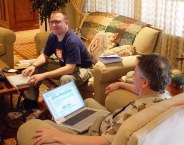 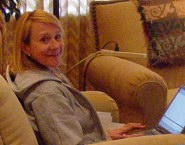 Cory Doctorow and Doc Searls posting to their weblogs from PC Forum, Esther Dyson getting ready
Quality of service discussion [link]
I just posted an essay on SATN.org with some observations about the Quality of Service issue.
Atlanta again: A Segway and the Blackberry advertisement [link]
I'm on my way back from another trip to Atlanta to work at Interland's headquarters. This time, I only saw one of the Ambassador Force people riding his Segway. (No pictures, unlike last time.) He was riding along with a group of about three pedestrians, explaining to them how to get somewhere. Their interaction (as seen by three of us from across the street) was quite natural and the Segway rider was an equal participant in that walking group -- there was little concern of him bumping into the walkers and hurting them as they walked along at a slow pace. Interestingly, moments later when we crossed the street we saw a policeman getting on his bicycle on the same sidewalk. Getting his balance (something a Segway rider does not have to be aware about), he clearly didn't fit in as well with pedestrians and they gave him a wide berth. Again, we see that whether or not Segways will fit in with foot traffic depends upon training and social norms, and perhaps "proper use legislation". Banning them outright is wrong.
Walking through the airports on the way to Atlanta and the way back, I saw this ad for using a RIM Blackberry hanging on the wall:
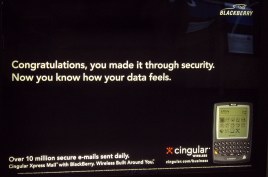 Ad in the airport after the security screening area: "Congratulations, you have made it through security. Now you know how your data feels."
At first I thought: "What a great ad! It fits in so well to take advantage of the situation with humor, yet relate it to a product benefit" (well, maybe my thoughts were not exactly in that marketing-speak language). For some reason, though, something bothered me about the mental image.
As I prepared to board the 6 am flight to Atlanta, I got called aside for a "sneaker and body search" at the gate. I emptied my pockets of all metal onto a table as instructed and took off my shoes. After passing the wand-scanner test with flying colors (though my metal jeans waist button requires them to touch my tummy or something, they tell me as I'm patted down), I collected my belongings. A little clip I had removed from one pocket was missing from the table. The attendant remembered seeing it, but it probably got lost in the shuffle as others were examined along with me. We couldn't find it on the table or floor, and I boarded the plane with a mental note to myself to place such things in a carry-on bag pocket before the next search.
The second time I saw the ad was in Atlanta, on the way home. This time I read the fine print: "Over 10 million secure e-mails sent daily."
"Wait," I thought, "that's wrong. That stressful, humiliating feeling I just felt going through 'security' is not what happens to secure email. They don't understand email, anti-terrorism, or security." I hate when people show such a lack of understanding and expect others to be the same.
Email security is about privacy, securely packaging the content and delivering it without change (or loss) to the intended recipient and to the intended recipient only. It's a nice feeling to think your email was treated so carefully. (Imagine it being wrapped securely in bubble wrap and then locked in a strong metal case for transport, handcuffed to the arm of a trusted associate.)
Airport security is different. It's about looking for bad "content" (literally), ignoring privacy (of content and one's physical person) if "necessary" to protect others. Imagine an email message from your partner being examined by strangers, jokes carefully examined for unintended meanings and political correctness, all while people who might be your competitors watch. Bad image. Airport security is more like anti-virus or maybe anti-spam. Is that what Cingular was advertising? Or is their type of "security" the type Hollywood would like that checks that your data doesn't contain "illegal" content?
Still, it seemed a clever ad at first. Too bad it exclaims "I don't know what I'm advertising or I don't understand what you just went through. We're all people who don't think deeply about important things, aren't we?" It's scary to think that at a time when we need to reexamine our society and figure out how we can maintain our values while dealing with the realities of the day someone would spend so much money on an ad that works only if you don't think carefully about the difference between protecting your data and exposing your belongings and not trusting you. Data security is like your mother looking after you. Airport security is like the final-exam proctor watching over you.
Search Engine Strategies 2003 conference report [link]
As part of my job as CTO of Interland I need to help provide vision on products and services for the "mass market" of small businesses. I've been working on driving the SMBmeta Initiative as part of that job. Some of the most influential people to whom I need to introduce the idea of SMBmeta were going to be in Boston for a conference about Search Engines, so I figured that attending would be good for many reasons. It turned out it was. Search Engine Optimization and Search Engine Marketing are important things to understand if you are interested in today's Internet, so I wrote a report after attending part of the conference.
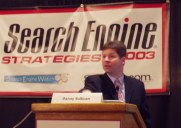 Danny Sullivan leading a session
Boston Museum of Science Computing Revolutionaries event [link]
I just got back from an event at the Boston Museum of Science whose purpose was to "Celebrate...the mission of The Computer Museum, The Computing Revolution exhibit, and [their] new focus on today's technologies and their impact on our lives." [Disclaimer: I'm on their Board of Overseers.] I'll cover the exhibit some other time (it has interesting artifacts like an Enigma machine, some of Whirlwind, Univac, PCs, VisiCalc
Tonight, they had three "special guests" each present a new group of "computer revolutionaries". The guests were Alan Kay (of Alto, Xerox PARC, Smalltalk, Dynabook, etc., fame), Esther Dyson (of Edventure), and Bob Metcalfe (inventor of Ethernet, etc.). Alan introduced Andreas Raab of the University of Magdeburg, Germany. Andreas is part of the Open Croquet project, along with Alan, David Smith, and David Reed (my friend who writes for SATN.org). They are developing a collaborative, P2P, very interactive 3D environment, which he demonstrated. Esther introduced John Frank of MetaCarta, a system that allows analysts to filter and visualize massive text collections using geographic locations and keyword searches (funded by the CIA's venture fund In-Q-Tel...). Finally, Bob introduced Cynthia Breazeal, Director of the Robotic Life Group at the MIT Media Lab, who showed us work on sociable robots that communicate emotions using gaze, facial expression, posture, and vocalization. All three were really cool. Take a look at their web sites for more info (it's too late to write much tonight).
Some pictures:
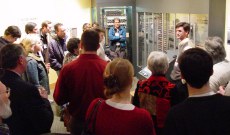   Part of the exhibit looking at a little piece of Whirlwind, Jeremy Allaire and Scott Kirsner, two of the many guests
   The Museum of Science's new president Yannis Miaoulis, Alan Kay, Andreas Raab
    Esther Dyson, John Frank, Bob Metcalfe, Cynthia Breazeal
|
||
|
© Copyright 1999-2018 by Daniel Bricklin
All Rights Reserved.
See disclaimer on home page.
|
||